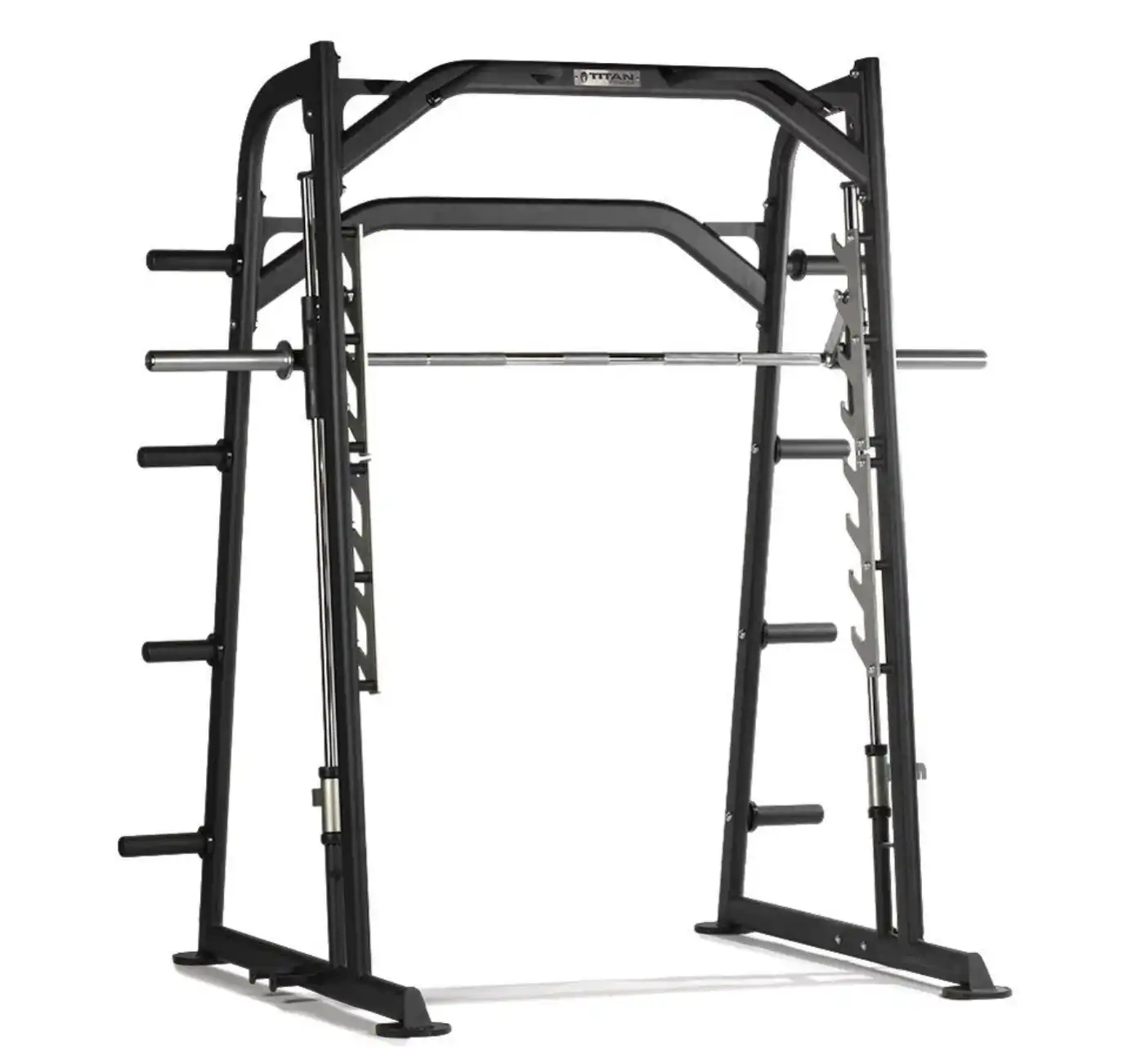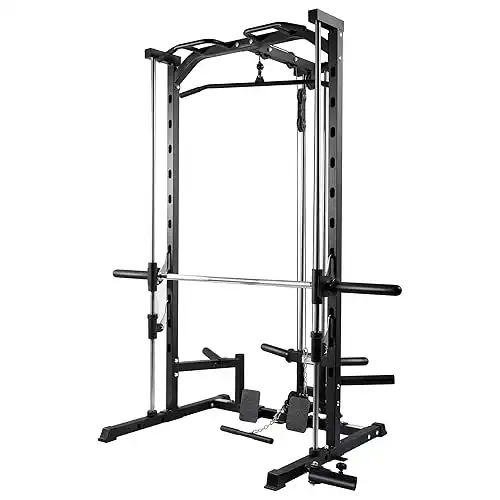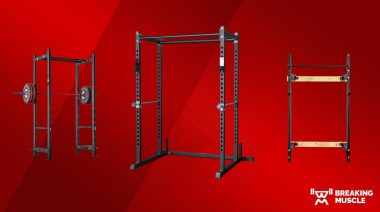Other than the almighty treadmill, there may not be a piece of equipment more synonymous with commercial gyms than the Smith machine. Boasting tremendous versatility and functionality, this muscle-building tool is popular among lifters of all experience levels.
However, you don’t need a gym membership to enjoy its benefits. While it may have not been a home gym staple years ago, the Smith machine has become a must-have for many fitness enthusiasts. Offering added protection without a spotter for your bench presses, back squats, deadlifts, and other strength exercises, the Smith machine is a wise investment for those trying to build the ultimate garage gym.
With options spanning from traditional Smith machines to all-in-one home gym solutions, you might feel a bit overwhelmed about which direction to go. Luckily for you, our team of expert product testers did all the due diligence necessary to separate the cream from the crop. From analyzing the build materials to testing the smoothness of the bar path to assessing the value, we took the time to dissect each element in order to narrow down our list to just five.
In addition, we got some valuable insight from Mauro S. Maietta, district fitness and education manager for Crunch Fitness, on the benefits and what factors to consider when you’re shopping for a Smith machine.
This content is meant to be informative, but should not be taken as medical advice. It is not intended for use as diagnosis, prevention, or treatment of health problems. Always speak with your doctor before starting any new supplement or exercise regimen.
Our Picks for the Best Smith Machines of 2025:
- Best Overall Smith Machine: Force USA G15 All-in-One Trainer
- Best All-in-One Smith Machine: Titan Fitness Smith Machine
- Best Compact Smith Machine: Bolt Fitness Supply Storm Series Stinger Attachment
- Best Budget Smith Machine: RitFit Smith Machine
- Best Smith Machine Attachment: Bulletproof VTS Lite Rack Attachment
Best All-in-One Smith Machine: Force USA G15 All-in-One Trainer
- 3-in-1 at-home gym machine
- Weight stacks and plate-loaded cable towers
- Half rack on the front
- Interchangeable 2:1 and 4:1 cable pulley ratios
- 18 functional attachments included
- Barbell or smith machine training
Pros:
- Highly customizable and versatile for a full-body workout
- Half squat rack on the front
- Space-saving design
- Weight plate and free weight storage
- Interchangeable 2:1 and 4:1 cable pulley ratios
Cons:
- Upgrades are expensive
- Entire unit weighs nearly 1,000 pounds
- Self-assembly is a big job (professional assembly is $800)
If you’re searching for a multifunctional Smith machine that’s compatible with a ton of attachments, the Force USA G15 is the machine that can truly do it all — albeit at an expensive price point of around $5,500. However, there’s a reason it earned 4.5 out of 5 stars for versatility from our top product tester: you can perform a wide variety of exercises by taking advantage of all of its functionality.
Tipping the scales at nearly 1,000 pounds, the G15 combines a functional trainer, half rack, and Smith machine into a single, sturdy unit. Measuring over 6 feet wide, over 4 feet deep, and about 7 feet tall, the G15 earns a 4-star footprint rating. While there are more compact options, it’s still a good option for folks with limited space, especially considering the versatility you get.
Offering dual 289-pound weight stacks that keep it well-anchored, the G15 also scores 4 out of 5 stars for durability and construction.
“This thing is like a tank,” our tester says. “Once it’s assembled, it’ll basically be stuck in place.”
Unfortunately, our tester wasn’t as impressed with the cable pulley material. Asthey’re made from nylon instead of aluminum, they don’t move as smoothly and won’t be as durable as their metal counterparts.
Something that separates the G15 from many competitors is its ability to go from a 2:1 or 4:1 pulley ratio. This gives you the ability to make the weight feel like half or a quarter of the actual weight. While our tester would prefer a 1:1 ratio for more effective resistance, he says the 2:1 or 4:1 ratios “will be adequate for most people working out from home.”
The G15 comes with a lengthy list of attachments, including J-hooks, safety spotter arms, multi-grip dip handles, a multi-grip pull-up bar, band pegs, and a low row footplate. If you want to unlock even more training possibilities, the $700 G15 Upgrade Kit includes three additional strength training stations, three functional attachments, a TV mount, and four storage shelves.
Two knocks against this ultra-versatile machine: assembly and value.
Although some of the parts arrive pre-assembled, our assembly expert recommends budgeting “at least 20 man hours” to get the G15 fully put together. And if you want to leave it to the professionals, you’ll need to pay an additional $800.
At nearly $6,000 on its own, the G15 certainly isn’t made for budget-conscious shoppers. Our top product tester gave it 3.5 out of 5 stars for value, noting that Force USA could use better quality components, cables, and accessories, including one of the key parts of this premium-priced unit: the built-in barbell.“The knurling is super passive and not going to allow for an adequate grip for the user if you were to go heavy on any Smith machine movements,” he explains.
Best All-in-One Smith Machine: Titan Fitness Smith Machine
- 600-pound weight capacity
- Very smooth and stable
- Features an angled design
- Counterbalanced
Pros:
- Durable design
- Smooth movement
- Feels stable when in use
- Only weighs 260 pounds
Cons:
- Barbell knurling could be better
- Only has a 1-year warranty
- Angled design may not suit some users’ preferences
Want to crush a full-body workout with a single piece of equipment? The Titan Fitness Smith Machine can be the all-in-one solution that allows you to train your upper body, lower body, and core in a safe, effective manner.
Is it as versatile as the G15? No. Is it far more affordable? Yes.
For less than a third of the price, you can still get an excellent workout experience from the $1,7000 Titan Smith Machine. One of our more seasoned product testers used it for a variety of strength training sessions, highlighting how impressed she was by the smooth glide of the barbell and the angled design. In addition, this Smith machine is counterbalanced so you don’t have to support the entire 45-pound barbell like you do on other machines. Beginners will appreciate this, as the bar only feels like 15 pounds.
Unfortunately, like Force USA, Titan left our team wanting more out of the knurling.
“It’s fine for a Smith machine, but it’s definitely not the most grippy bar,” our tester says.
On the other hand, this machine earns high marks for its ergonomics. Our tester rated it 4 out of 5 stars in this category. She found the single-axis, angled design helped improve her muscle activation during lower-body weight training exercises like Smith machine squats and lunges.
Most importantly, she felt completely secure using this Titan machine. Not only was there no wobbling or shaking, but the bar moved smoothly, leading her to give a 5-out-of-5 rating for stability.
“This is a super stable machine; there was no give to it even when we were using heavy weights,” our tester says. “This was ultra-smooth.” While Titan priced this machine fairly, we’d like to see a better warranty. A one-year policy falls well short of what we expect from most brands. Plus, if you want to return a piece of equipment, you must pay the return shipping costs and a 20% restocking fee. That results in a disappointing customer experience score of just 2 out of 5 stars.
Best Compact Smith Machine: Bolt Fitness Supply Storm Series Stinger Attachment
Pros:
- Compact Smith machine attachment
- Attaches to racks or extends with included uprights
- Smith machine bar included
- 12 different positions totaling 60” of vertical adjustment
- Includes multi-grip pull-up bar
Cons:
- Smith bar has passive knurling
- Only compatible with 3” x 3” racks with 1” holes
- 55-pound bar might be too heavy of a starting weight for certain users
Don’t want a standalone Smith machine? Bolt Fitness has a space-saving solution in the form of the Storm Series Stinger Smith Machine Attachment. Compatible with any 3” x 3” frame using 1” hardware, this universal attachment can seamlessly integrate with your existing squat or power rack, opening the door to even more training possibilities.
We rate this Smith machine attachment a 4.5 out of 5 for versatility, as it offers 12 different positions totaling 60” of vertical adjustments. That means you can quickly go from a steep incline bench press to a Romanian deadlift, making your workouts more efficient, too. Plus, we also like that this attachment has a 43” built-in multi-grip pull-up bar, giving you the ability to develop your vertical pulling strength and endurance.
Bolt also earns solid marks for construction, earning 4 out of 5 stars in this key category. However, our chief product tester warns not to expect quite the same level of craftsmanship as some better-known brands.
“You won’t see the same quality welds or powder coats from Bolt as you will from Rogue or REP,” he says.
Like several other nominees on this list, our tester was also disappointed with the Smith bar’s knurling. The passive knurl pattern won’t give you a particularly stable grip, especially when using heavier weights.
“You definitely won’t mistake this for an Olympic barbell,” our tester says.
As for the price? At around $1,100 this is on the expensive side for a Smith machine attachment. For example, the Bells of Steel Smith Machine Rack Attachment is much more affordable at $800. We rate it a 3 out of 5 for value, especially since you already need a rack to use it. Otherwise, expect to invest a significant chunk of change to get a fully functioning setup.
Best Budget Smith Machine: RitFit Smith Machine
Pros:
- Affordably priced
- Free shipping
- Includes plate storage tubes
- Only weighs 140 pounds
- 3-year warranty
Cons:
- Maximum weight claims are exaggerated
- Build materials are not the highest quality
- Barbell knurling is almost non-existent
Just because you can’t afford to splurge on something like the G15 doesn’t mean you can’t find a Smith machine that fits within your budget. If you don’t have a ton of financial wiggle room, the RitFit Smith Machine is the most affordable option that earned our stamp of approval.
As our top product tester puts it, “If you’re looking for a Smith machine and you’re on an ultra-budget, this is it.”
At about $500 on Amazon, this machine is less than a third of the price of the Titan Fitness Smith Machine and less than a tenth of the cost of the G15. Of course, it’s not the most durable option on the market, but it offers sufficient versatility at a very attractive price point to earn a near-perfect value rating of 4.5 out of 5 stars.
Dubbed the “sleeper pick” by our tester, he notes that “the low price covers so many sins.”
Before we dive into some of RitFit’s shortcomings, let’s highlight some of the strengths of this machine. First, we rated it 4 out of 5 for versatility, as it offers built-in low row and lat pulldown capabilities using a plate-loaded cable pulley system that holds 165 pounds. The RitFit Smith Machine also comes with several attachments, including a pin-on landmine row and two multi-purpose pull-up handles.
Secondly, it has a compact design that makes it suitable for home gym setups with limited space. It also weighs just 140 pounds, making it easier to move than other options on this list.
However, our tester had several callouts about the RitFit Smith Machine that deserve mentioning. With cheaper build materials and a lightweight design, it didn’t prove to be as stable as he would have liked, earning just 3.5 out of 5 stars for both construction and stability. Needless to say, this isn’t the best option if you want to lift heavy weights. Still, considering you could pay around the same price for a high-quality Olympic barbell, the RitFit Smith Machine is a solid option if you’re on a limited budget.
Best Smith Machine Attachment: Bulletproof VTS Lite Rack Attachment
Pros:
- Converts your squat rack into a Smith machine
- Works with 7’ Olympic barbells
- FSA/HSA eligible
- Multiple latch hook and size options to accommodate different racks
Cons:
- Not designed to be dropped
- VTS Lite only has rollers on two sides of the upright; the VTS has rollers on all four sides
Imagine if you could turn your squat rack into a Smith machine in a matter of minutes. That dream can be a reality if you’re willing to invest around $700 on the VTS Lite Rack Attachment from Bulletproof Fitness, a lesser-known fitness equipment manufacturer that’s caught our attention.
While we haven’t gotten our hands on this attachment just yet, it’s hard not to get excited about the concept and execution by Bulletproof. The Versa Trolley System (VTS) Lite allows you to convert your squat rack into a Smith machine using your own barbell. The rollers are made from UHMW plastic, an ultra-durable material we’ve seen used on other racks. This attachment only weighs 15 pounds, making the VHS Lite a more user-friendly alternative than the full-sized VTS, which weighs in at 24 pounds. From a construction standpoint, we feel comfortable giving the VTS Lite 4 out of 5 stars.
In addition, we like that Bulletproof offers a wide range of options to accommodate different racks. You can choose between a 3” x 3” pair, a 2” x 3” pair, or a 2” x 2” pair. You also can choose different hook sizes based on the diameter of your barbell. This optionality, along with the added exercise variety you get from using the attachments, earns a 4.5 out of 5 for versatility.
Set to be released in May 2025, we’re excited to see this product in action. If you want a more streamlined solution than getting a standalone Smith machine, this is an attractive space- and money-saving solution. Based on the price and versatility, we give it a value rating of 4 out of 5 — though it could go higher once we get our hands on it.
How We Picked and Tested the Best Smith Machines
As Smith machines have become more popular among the home gym community, we’ve ramped up our efforts to test ones from a variety of brands. This has allowed us to develop a thorough evaluation process that examines a number of key factors that impact your workout experience.
With options ranging from standard Smith machines to all-in-one trainers with cable machines, here’s what we assess during testing using a 1-5 scoring system:
- Construction: What gauge steel are the uprights made from? Does the Smith bar have passive knurling or a knurl pattern that provides good grip? Does the design allow for a stable, secure weightlifting experience?
- Footprint: How much space does the Smith machine take up? While a large footprint isn’t necessarily a dealbreaker, we understand that many home gym owners have limited space. A compact footprint gives you more room to store your adjustable dumbbells, weight bench, and whatever else you want to fit in your training space.
- Versatility: One of the reasons bodybuilders rely on Smith machines is their versatility, as they allow you to train different muscle groups without having to move from machine to machine. Meanwhile, ones that have built-in functional trainers or offer a power cage combo give you even more versatility and functionality to accomplish your fitness goals.
- Value: Is the price justified by the build quality, durability, and functionality? Just like a high price tag doesn’t guarantee high quality, a low price point doesn’t mean you can’t get great bang for your buck.
Benefits of a Smith Machine
What makes a Smith machine such a valuable training tool? If you’ve ever used one, you already know there’s added peace of mind knowing you have built-in support. Here’s an overview of the different benefits of utilizing this popular piece of equipment.
Improved Stability and Safety
Unlike when you use a barbell and squat rack, the Smith machine provides a fixed bar path. This can help reduce the risk of injury and ensure a stable lifting environment.
“The Smith machine helps the athlete feel supported and gives them greater control and stability when performing an exercise,” says Mauro M. Maietta, district fitness and education manager for Crunch Fitness.
In particular, new lifters can benefit from starting out on a Smith machine so they can focus on their form while being supported by the machine.
“Maintaining correct form is important for avoiding injuries and maximizing the effectiveness of your workouts,” says Dr. Christopher Mohr, PhD, RD. “Beginners might benefit from working with a personal trainer initially or taking a beginner class to learn proper techniques.”
Can Be Used for Injury Rehabilitation
The guided motion and added stability of a Smith machine makes it an ideal training tool for those returning from injury or anyone with mobility issues. It encourages proper form and can be a safer way to increase your strength and joint stability before moving on to free weights.
Maietta recommends starting with lighter weights to get a feel for the range of motion before progressing. “The fixed range of motion is not for everyone, so be sure to speak with your local fitness professional and listen to your body and joints if you feel any discomfort or pain during the planned movements,” he says.
Allows You to Train Without a Spotter
If you prefer to work out alone or don’t have a training partner available, the Smith machine can act as a “spotter” for you. These machines offer an extra layer of safety, as you can easily rack the bar or set the safety spotters to a specific point that will keep you out of harm’s way.
In addition, this advantage allows you to safely follow progressive overload, a proven method for increasing muscle size and strength.
“This continual challenge helps your muscles grow stronger,” says Mohr. “It’s important to start with manageable increments to prevent injury.”
Versatility in Exercise Selection
You won’t find many machines that offer as much versatility as the Smith machine. Want to train legs? You can knock out squat and lunge variations. Want to grow your chest and shoulders? Grab an adjustable weight bench and work on your bench press and overhead press without having to worry about keeping the bar stable. A high-end option like the Force USA G15 gives you the ability to perform cable exercises like cable crossovers, chest flys, and overhead triceps extensions.
“The Smith machine can be seen as the Swiss army knife of the weight room since it allows for several strength training exercises in its fixed vertical path, ranging from squats to overhead pressing movements,” says Maietta.
How To Choose the Best Smith Machine for Your Home Gym
What should you consider when choosing a Smith machine? Based on our experience as equipment experts and dedicated lifters, here’s what we recommend:
Size
Consider the machine’s footprint when determining if it is a good fit for your needs. One benefit of Smith machines is all-in-one trainers are available to consolidate the space needed for multiple workout stations.
Other Functions
Many of the home gym Smith machine options on this list are designed as all-in-one trainers designed to provide multiple workout functions with one convenient machine. The machine can include stations for a power rack, functional trainer, low-row attachment, chin-ups/pull-ups, dips, suspension trainers, and more.
Weight Ratio
Smith machines offer pulley systems with varying weight ratios, including 1:1 and 2:1. A 1:1 ratio means the weight you load is the exact weight you lift. A 2:1 ratio means you lift half of the weight you load. For instance, with a 2:1 ratio, if you load 100 pounds, you lift 50 pounds.
Some Force USA Smith machines, including the G15, allow users to easily switch between 2:1 and 4:1 ratios, which is helpful when people of various skills use the same machine.
Weight Capacity
Weight capacities vary depending on the functions offered by the machine. The weight capacities on this list start at 300 pounds. Be sure to confirm the machine’s weight capacity can accommodate your needs..
Best Smith Machine: Final Thoughts
If you are looking for versatile strength-building home gym equipment to achieve a full-body workout, a Smith machine can help you achieve your goals. Since the 1950s, this game-changing machine has allowed gym-goers to work out safely without a spotter. Today, there is a wide range of consumer options, allowing you to experience the benefits of the Smith machine in the comfort of your own home gym.
Smith Machine FAQs
Smith machines all perform similar functions, but there are different types of Smith machines available. For instance, some Smith machines provide a vertical path for motion, while other Smith machines provide a slightly angled path. Some Smith machines may be limited to the Smith machine function, while others are designed to be all-in-one machines with multiple stations for different exercises. Smith machines vary based on the manufacturer.
Yes, you can deadlift on a Smith machine, but whether you should depends on your skills and ability.
Maietta suggests thinking through the following questions before performing moves on a Smith machine:
-How is your range of motion?
-Do you have the proper form or mobility to perform these compound moves?
If you do not know, Maietta suggests working with a local fitness professional who will be able to help coach you and correct your form if necessary.
Yes, you can build muscle with the consistent use of a Smith machine. Smith machines are considered a good strength and muscle training option for beginners or those without a spotter. However, the drawback is motion is limited to a specific vertical (or slightly angled) path. For sports-specific muscle building, some experts prefer free weight exercises.
Yes, you can squat with a Smith machine. Safety features such as hooks and stoppers can help provide extra protection. Again, be mindful of your abilities and consult with a fitness pro if you are unsure of how to do this safely and with proper form.











